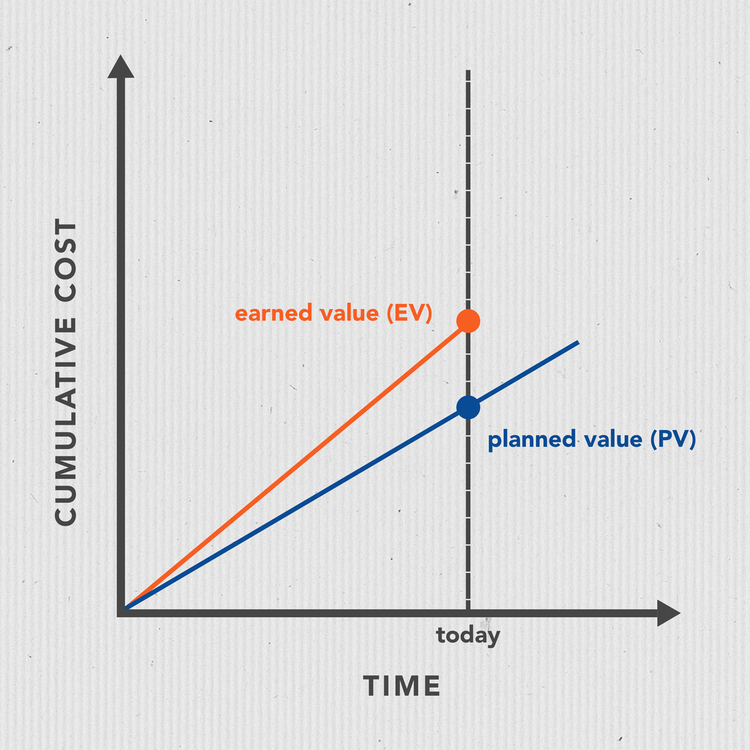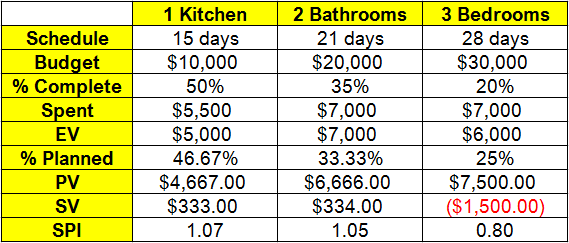Schedule Variance 101: Keeping Your Project on Schedule
In project management, failing to keep things on schedule can trigger a causal sequence that can be catastrophic for the overall project.
That’s because according to the triple constraint, also known as the project management triangle, which illustrates the relationships between the three major constraints of time, cost, and scope, any change in one affects the other two.
- If your project is running late, you may need to onboard more people to make up for lost time. That also means more costs to worry about. Or to keep it on schedule, you may have to deliver a project with less features than planned. The same is true if a project has to be delivered earlier to stay one step ahead of a competitor that’s about to release a similar product, for example. Either you increase the budget to hire more people to do the work or decrease the project’s scope.
- If the project has gone beyond what’s indicated in the scope of work -- either you’re in scope creep territory or the product took on a life of its own and is shaping up to be way different than originally planned -- expect your schedule or budget, or both, to be affected.
To achieve a healthy balance, constant monitoring and analysis are paramount. Project leaders should employ various project management techniques to track and measure the project’s progress.
One such technique is earned value management (EVM). It functions as an early warning device that alerts project managers to possible problems so they can manage them.
Schedule variance (SV), a subset of EVM, measures how well a project is doing vs. pre-approved timelines.
Overview: What is schedule variance in project management?
Schedule variance indicates whether your project is on schedule, behind schedule, or ahead of the project schedule -- and by how much. It calculates the difference between the cost of the actual work completed (earned value) and the cost of the planned work to be completed as of today (planned value).
Schedule variance measures how much the project is deviating -- or varying, as the word “variance” in the name suggests -- from the schedule to date.
To further illustrate the concept, consider the graph below.

The earned value is greater than the planned value. This means, as of today, you did more work than planned. Therefore, your project is ahead of schedule. Image source: Author
Again, the difference between EV and PV is your schedule variance. Take note that if the schedule variance is:
- Positive: More work has been done than scheduled, so your project is ahead of schedule.
- Negative: A negative schedule variance means less work is complete than planned, so your project is behind schedule.
- Zero: All planned work has been completed, so your project is right on schedule.
More on PV, EV, and other schedule variance values in the “calculate schedule variance” section below.
Schedule variance vs. cost variance: What's the difference?
Both schedule variance and cost variance are earned value analysis components. They calculate variances, which are measurable changes or deviations from a baseline or standard.
The schedule variance lets you know if your project is behind, on, or ahead of schedule, while the cost variance indicates whether or not your project is on, under, or over budget.
Both are critical for monitoring and communicating the project’s progress, detecting problematic baseline deviations, and adjusting to stay on course if necessary.
To compare, the schedule and cost variance formulas are expressed as follows:
- Schedule Variance (SV) = Earned Value (EV) - Planned Value (PV)
- Cost Variance (CV) = Earned Value (EV) - Actual Cost (AC)
You can learn more about cost variance and see some examples if it's still unclear.
Why is schedule variance important for small business project management?
One way to underscore the importance of staying on schedule, which is ultimately what schedule variance is about, is by recognizing the negative consequences of project delays.
Cost overruns
If you factor in overtime and additional resource expenses to make up for the difference between the actual and planned schedule, you end up with a project that’s bound to go over budget sooner rather than later.
Cash flow problems
A business has cash flow problems if it’s unable to pay its bills and expenses when they come due, and small business owners are no stranger to cash flow challenges.
When your company depends on your projects being completed on time to pay its debts and fulfill its obligations, the schedule variance lets you know if you’re on track.
Lawsuits
Contracts protect the parties involved in a transaction. If you’re contractually bound to deliver a project by a certain date, and you’re unable to do so, lawsuits may follow, especially if the other party loses revenue or cannot fulfill its own obligations as a result of your failure to meet your project deadlines.
Project abandonment
Some projects don’t make it to the end, and the inability to meet deadlines or “deviation from timetable” is one of the major reasons. In this case, some companies feel it’s more prudent to cut their losses than incur more costs -- or worse, debt -- than they can afford.
Erosion of trust
If you’re unable to meet your timeline requirements, clients and higher-ups may lose faith in your ability to deliver timely results. Being mindful of your SV in project management allows you to:
- Keep the project on schedule.
- Complete the project within budget.
- Understand how much work has been completed to date, so you can use resources more efficiently to finish what’s left of the project.
- Communicate to stakeholders about the project’s progress vs. timeline expectations using a number that’s easy to interpret.
How to calculate schedule variance
Let’s say you’re working on a house renovation project, and you have a cost and schedule breakdown that looks something like this:

I pulled the numbers out of thin air, so please pardon me if they don’t reflect reality. Image source: Author
After one week, you go back to your spreadsheet to see how your team is doing. You now have the following:

One week into the renovations, your team has completed 50%, 35%, and 20% of the work, spending a total of $19,500.
Although these numbers are all essential project data, they don’t say right away what you want to know: Are the renovations on schedule This is where schedule variance comes into play.
To reiterate, the schedule variance formula is:
Schedule Variance (SV) = Earned Value (EV) - Planned Value (PV)
To find the earned value, which is the value of the actual work completed to date, multiply the percentage of the actual completed work by the project’s total budget, also referred to as budget at completion (BAC).
The formula for earned value is:
Earned Value (EV) = % of Actual Completed Work x Budget at Completion (BAC)
Using the above formula to arrive at the earned value of the kitchen renovation, we have:
- EV = 50% x $10,000
- EV = $5,000
To find the planned value, which is the approved value of the work scheduled to be completed to date, multiply the percentage of the planned completed work by the project’s budget.
The formula for planned value is:
Planned Value (PV) = % of Planned Completed Work x BAC
Since the kitchen has a completion schedule of 15 days, after seven days, completed work should be 46.67% (divide 7 by 15). Using that formula to get the kitchen renovation’s planned value:
- PV = 46.67% x $10,000
- PV = $4,667
Now that we have both the EV and PV, we’re ready to find the schedule variance (SV = EV - PV):
- SV = $5,000 - $4,667
- SV = $333
Since $333 is a positive number, the kitchen renovation part of the project is ahead of schedule. It also shows that you’ve completed an additional $333 worth of work than planned.
When you’re done finding the SV for each segment of the project, your spreadsheet will now look like this:

Both the kitchen and bathroom renovations are ahead of schedule, while the bedroom side of the project is behind schedule. Image source: Author
Schedule performance index
Another EVM formula that compares actual project performance against the schedule is schedule performance index (SPI), which measures how close the project is to planned completion to date.
SPI in project management is calculated as follows:
SPI = EV / PV
If the SPI result is:
- Greater than one: The project is progressing well vs. the schedule.
- Equal to one: The project is on schedule, exactly as planned.
- Less than one: The project is behind schedule.
Going back to the kitchen renovation example:
- SPI = $5,000 / $4,667
- SPI = 1.07
This SPI figure indicates that the project is ahead of schedule. It also means that for every hour of work, your team is completing work that’s worth 1.07 hours.
Updating the spreadsheet further to include SPI, we now have:

SPI reinforces what SV already indicates. Both the kitchen and bathroom renovations are ahead of schedule, while the bedroom project is running behind. Image source: Author
Determine the project’s status with schedule variance
In the project planning phase, project performance details are fleshed out, including how you plan to tackle project risk management. But even sound planning and scheduling can’t save a project if your tracking and monitoring practices aren’t up to par.
With schedule variance, not only do you have a simple, easy-to-understand number that indicates how your project is faring against the schedule, you also know by how much -- allowing you to pivot as necessary and steer the project back on track if needed.
If you need help communicating relevant schedule and cost data with your team, plus a place to keep all project-related documents on demand 24/7, check out some of the best project management software options The Ascent has reviewed so far.
Alert: our top-rated cash back card now has 0% intro APR until 2025
This credit card is not just good – it’s so exceptional that our experts use it personally. It features a lengthy 0% intro APR period, a cash back rate of up to 5%, and all somehow for no annual fee! Click here to read our full review for free and apply in just 2 minutes.
Our Research Expert
We're firm believers in the Golden Rule, which is why editorial opinions are ours alone and have not been previously reviewed, approved, or endorsed by included advertisers. The Ascent does not cover all offers on the market. Editorial content from The Ascent is separate from The Motley Fool editorial content and is created by a different analyst team.
Related Articles
View All Articles